This entry includes a walking tour! Take the tour.
Introduction
Text-to-speech Audio
Images
West Virginia's State Capitol was constructed from 1924 to 1932 and the building is the tallest in the state.
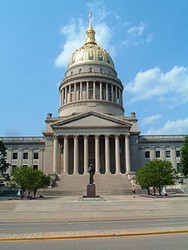
Linsly Institute Building, the capitol from 1863-1870.
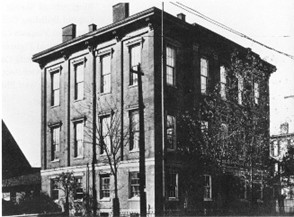
A depiction of the first Charleston capitol, 1870-1875.
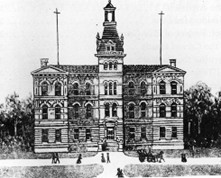
West Virginia's Victorian-era capitol, 1885-1921.
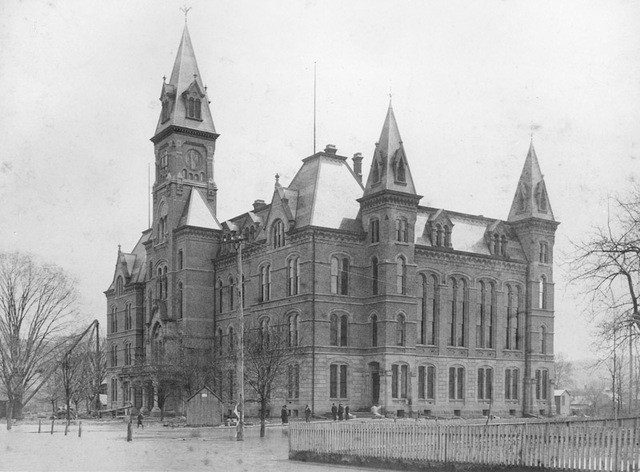
The Downtown Charleston Capitol caught fire on January 3rd, 1921.
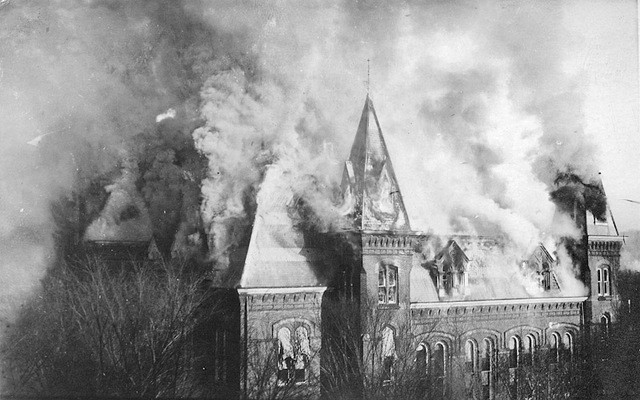
Construction of the West Wing- May 1924.
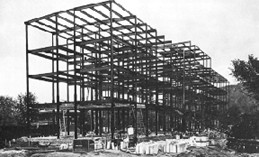
The two wings completed without the main building- March 1930.
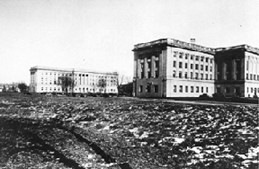
Construction of the Supreme Court Chamber.
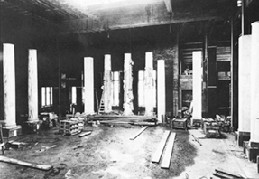
Construction of the dome- March 1931.

Interior construction of the dome- April 1931.
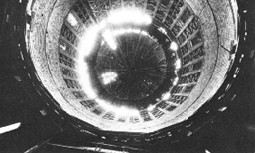
Cass Gilbert, the architect of the WV State Capitol.
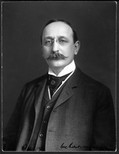
The Pasteboard Capitol: March 1921 to March 1927.
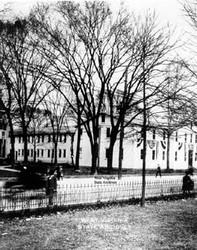
The Capitol Annex where important documents were stored and saved from the fires of 1921 and 1927.
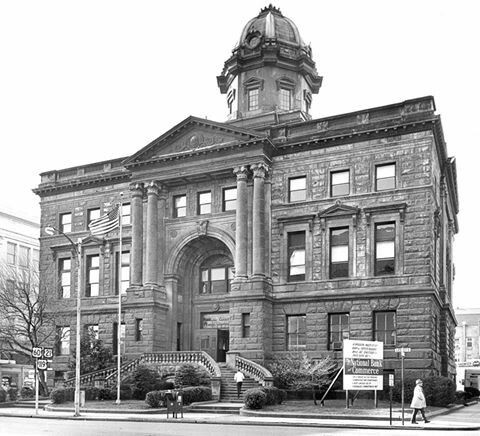
The dome of the capitol building.
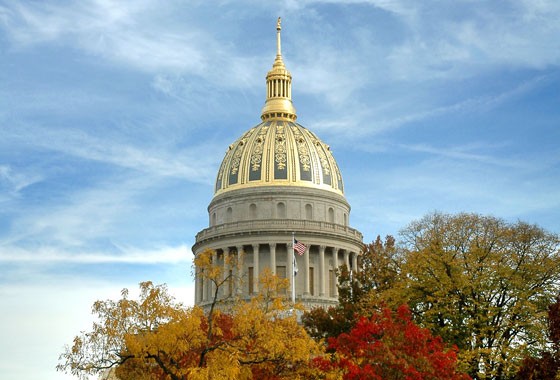
The capitol rotunda.
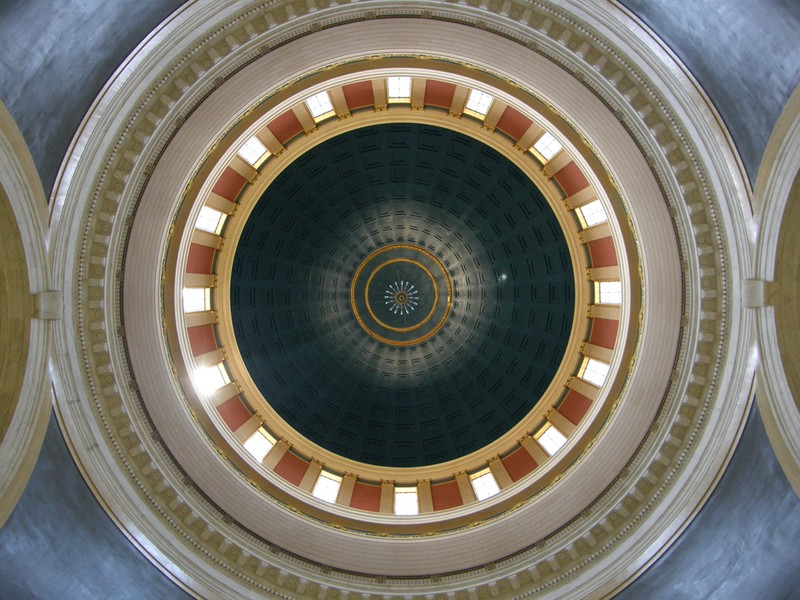
Backstory and Context
Text-to-speech Audio
When West Virginia officially became a state in 1863, the Linsly Institute in Wheeling served as the seat of government. However, a shift in political power in the new state occurred in the late 1860s, and the capital was moved to Charleston. Radical Republicans who controlled West Virginia’s legislature were outvoted and replaced by the Democratic Party after the establishment of the Flick Amendment that not only enfranchised African Americans but also restored voting rights to West Virginians who served as Confederate soldiers. Many of these Confederates were Democrats, especially in the southern and central portions of the state. Before the decision to move the capital to a more centralized location was made, Democrats had already taken hold of the local government in Charleston. After power was secured at the state level, the Democratic Party decided to transport the capital of West Virginia from Wheeling, a Republican-controlled area, to Charleston.
On January 29th, 1869, both Democrats and Republicans in Charleston convinced the city council to offer the state $50,000 to improve public buildings so that Charleston could make a claim to become the capital. Local Charleston officials were sent to Wheeling as lobbyists to propose the plan and to gain support for the moving of the state capital. The efforts were successful, and the act to move the state capital was passed on February 26th, 1869 with a vote of 29 to 23 in the House of Delegates and 17 to 4 in the Senate.
The governor of West Virginia, William E. Stevenson, boarded the steamboat “Mountain Boy” along with other state officials and necessary documents and records on March 28th, 1870. The vessel was referred to as the "floating capitol" in a tongue-in-cheek manner as it traveled down the Ohio River and up the Kanawha, and was the primary source of moving the capital from Wheeling to Charleston. The boat temporarily stopped in Governor Stevenson’s hometown of Parkersburg, and then continued to its destination. The Mountain Boy arrived in Charleston on March 30th and was welcomed by a local U.S. artillery unit. Mayor J. W. Wingfield delivered an address to a large crowd in front of Laidley’s Drug Store celebrating Charleston's status as the capital city of the newest state in the Union.
The state legislature's act stated that Charleston would become West Virginia’s capital on April 1st, 1870. However, upon Mountain Boy’s arrival, the new capitol building was not complete and would not be ready until December 20th, 1870. While the three-story hand-quarried stone building was being constructed, the Bank of the West and the Merchants Bank provided office space for executive officers. Saint John’s Episcopal Church temporarily served as the state library. When the capitol building was finally complete, it stood on land made available by Alex T. Laidley and J. A. Lewis, located where the Kanawha Valley Bank and the Diamond Department Store now stands.
Charleston's status as the capital of West Virginia brought expansion and growth, but it did not spare the city from natural disasters. A fire in 1873 destroyed most of the local structures. John P. Hale, who had influence in constructing the state capitol, along with a popular local hotel, declared bankruptcy after the fire and moved out of state to rebuild himself. In 1875, Senator Jonathan M. Bennett proposed a bill in the state legislature for the temporary removal of the capital in Charleston, and to be moved back to Wheeling. The vote ended in favor of removal with a 13 to 11 victory in the Senate, and a 38 to 20 victory in the House of Delegates. The capital of West Virginia was transported back to Wheeling aboard the Emma Graham on May 21st, 1875. However, Charleston leaders sought to prove that the action of the legislature was unconstitutional. The case went all the way to the state Supreme Court which ruled in favor of the legislature and Wheeling.
In February of 1877, the state legislature announced that the permanent location of the state capital would be decided by the people. Voters could select Clarksburg, Martinsburg, or Charleston, and the voting would take place on August 7th the same year. Charleston officials rallied to gain votes by collaborating with Booker T. Washington and other Black leaders to secure votes from the small but significant number of African Americans in the southern portion of the state. Charleston leaders even joined John Robinson’s traveling circus for a week to plead their case to voters. When the ballots were cast, Charleston won by a landslide, and Governor Henry M. Mathews announced that Charleston would once again be the West Virginia State Capital on May 3rd, 1885. The Belle Prince steamboat towed the Nick Crawley barge, which was carrying state property and documents, while the steamboat Chesapeake carried the state officials along with the governor.
The old capitol building was razed to make way for a new structure in the block surrounded by Capitol, Lee, Dickinson, and Washington Streets. The new three-story West Virginia State Capitol Building cost $389,923, and contained 85 rooms along with a 194-foot-tall clock tower. In 1902, the Capitol Annex was constructed between Hale and Dickinson Streets and housed various government agencies.
On January 3rd, 1921, the West Virginia State Capitol caught fire. Governor John J. Cornwell reportedly claimed that the guns and ammunition intercepted during the Mine Wars and stored in the attic of the capitol was the cause of the fire. After the fire, the Governor had a temporary office in the state armory while other agencies worked out of the Red Cross Shop, the Elks Club, the Cohen Building, the downtown Methodist Episcopal Church, the Scottish Rite Cathedral, and the Virginia Land Bank Building. In 1921, the state legislature held its session in the local YMCA.
A temporary wood-frame capitol building was constructed and completed in just two months and was located on the property across the street from the old capitol building. That structure also caught fire and was destroyed on March 2nd, 1927. That location of the temporary capitol building that served the state from 1921 to 1927 is now home to the Daniel Boone Hotel building. The former capitol annex later became the Kanawha County Public Library. That building caught fire in 1966 and was demolished to make way for Huntington Square.
Plans were made to build a new capitol under Governor Ephraim F. Morgan and the Capitol Building Commission, who hired architect Cass Gilbert. The west wing of the new capitol building was completed on April 24th, 1925, while the east wing was completed on December 12th, 1927. The central portion of the current capitol was dedicated on June 20th, 1932, on West Virginia’s 69th birthday. Gilbert’s original design for the capitol complex showed a dome and rotunda in the main structure. The dome was to be gilded copper to give the appearance of gold despite hesitation from state officials who stated that the project would be too expensive.
"If we had built the dome of stone, as in the Arkansas Capitol," he said, "or of marble, as in the Minnesota Capitol or the Rhode Island Capitol, it would have cost five or ten times as much money. In other words, the bell of the dome of this dimension in marble might easily have cost $500,000, whereas the comparatively modest expense for covering it with newly developed material of lead coated with copper and using gilding, has reduced the cost to a minimum... if the bell of the dome were of limestone it would be, in this climate, susceptible to expansion and contraction and the joints would have to be constantly repaired in order to preserve it." – Cass Gilbert1
The dome peaks at 292 feet, which makes the capitol the tallest building in West Virginia. The building is also four and a half feet taller than the nation’s capitol in Washington. The capitol’s marble rotunda is adorned with symbols representing the heritage of the Mountain State. Costing nearly ten million dollars, the building itself is 535,000 square feet with 333 rooms and chambers. Two-thirds of the interior is comprised of various types of marble while the exterior is fashioned from Indiana Limestone.
Sources
Damron, Robert A.. A Commemorative History . The West Virginia Capitol, vol. 4. Published May 1st 2006.
Cohen, Stan "Capitols of West Virginia." e-WV: The West Virginia Encyclopedia. 19 May 2016. Web. 09 February 2017.
Damron, Robert. "The Capitol." e-WV: The West Virginia Encyclopedia. 19 May 2016. Web. 09 February 2017.
Peyton, Billy Joe. Then & Now: Charleston. Charleston, SC. Arcadia Publishing, 2010.
Charleston Century Chronicle.
Charleston: A Capital Experience. Atlanta, Georgia. Riverbend Books, 2000.
Rice, Otis K.. Charleston and the Kanawha Valley. Windsor Publications, Inc, 1981.
Morgan, John G.. Charleston 175. Charleston, WV. The Charleston Gazette, 1970.
Laidley, W. S.. History of Charleston and Kanawha County West Virginia and Representative Citizens. Chicago, IL. Richmond-Arnold Publishing Co..
Rice, Otis K.. Brown, Stephen W.. West Virginia: A History. Lexington, KY. The University Press of Kentucky, 1985.
Building the Capitol: Part 3. Accessed February 09, 2017. http://www.legis.state.wv.us/educational/capitol_history/pg16-20.cfm.
State Capitol. West Virginia Division of Culture and History. Accessed February 08, 2017. http://www.wvculture.org/agency/capitol.html.
